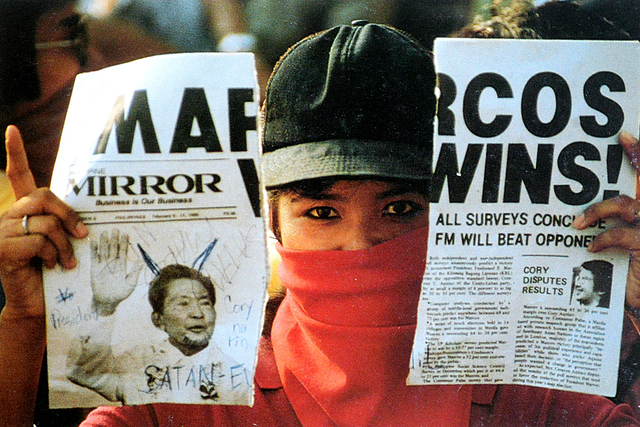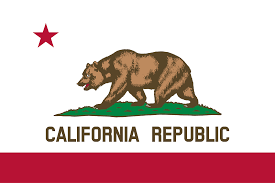1986 EDSA PEOPLE POWER REVOLUTION: RAPPLER IQ – RETRO – Newspaper front pages during the 1986 People Power Revolution Remember what the front pages of Philippine newspapers looked like during the ‘bloodless’ revolution that toppled a dictatorship in 1986?
CHRONICLES. Events throughout the People Power Revolution in 1986 grace the front page of newspapers. Photo by lifted from the book Bayan Ko! / Published 9:00 AM, February 21, 2016 / Updated 5:45 PM, February 21, 2018
.

Her first exposure to journalism was through the tabloids and broadsheets her grandfather always asked her to buy from the neighborhood stand. She would often take her time walking back home just to finish reading the articles on each page.
Jodesz, however, only got involved in the field when she took up journalism at the University of the Philippines Diliman. Aside from studying the craft, she also taught campus journalism to high school and elementary students as part of the UP Journalism Club.
In 2013, she took part in Rappler’s senatorial elections coverage as an intern. A year after, barely out of college, she joined Rappler as an official employee.
Jodesz wants to achieve a lot of things. But right now, she just wants people to correctly spell her name.
.
MANILA, Philippines – Philippine media played a big role during the People Power Revolution in 1986.
The country’s newspapers chronicled the events that transpired from February 22 to 25 which ended the 21-year rule of then dictator Ferdinand Marcos.
32 years after that uprising, Rappler looks back at how the front pages of Filipino newspapers – the Philippine Daily Inquirer, Bulletin Today (now Manila Bulletin), and the Manila Times – looked like throughout the 4-day “bloodless” revolution that ultimately led to the toppling of the dictator.
Note: Swipe left or right on the photos to navigate.
FEBRUARY 22, 1986


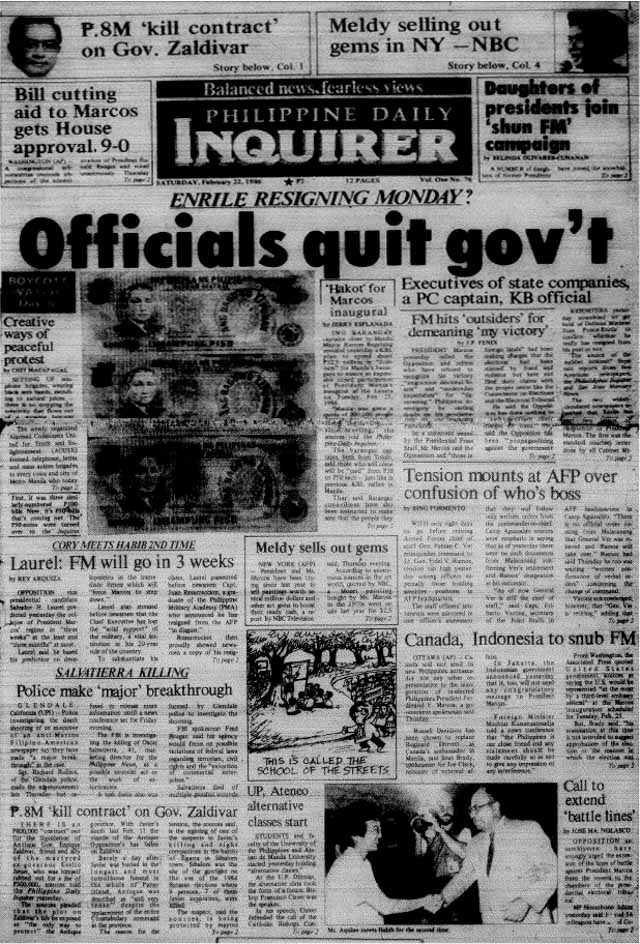
HIGHLIGHTS
- Then president Ferdinand Marcos met with the US ambassador to the Philippines at the time Stephen Bosworth and White House envoy Philip Habib who was sent by then US president Ronald Reagan. Habib, before leaving Malacañang, said that “Cory won the election and deserves our support. Marcos is finished, and we ought to offer him asylum.”
- Former Armed Forces of the Philippines (AFP) Vice Chief General Fidel V. Ramos and then defense secretary Juan Ponce Enrile announced they had withdrawn their support for Marcos.
- Former Manila Archbishop Jaime Cardinal Sin, over Radio Veritas, asked Filipinos to leave their homes and support Enrile and Ramos.
- Before the day ended, Marcos assured the nation that everything was under control and called on Enrile and Ramos “to stop this stupidity and surrender.” Enrile, over Radio Veritas, rebutted by saying, “Enough is enough.”
FEBRUARY 23, 1986
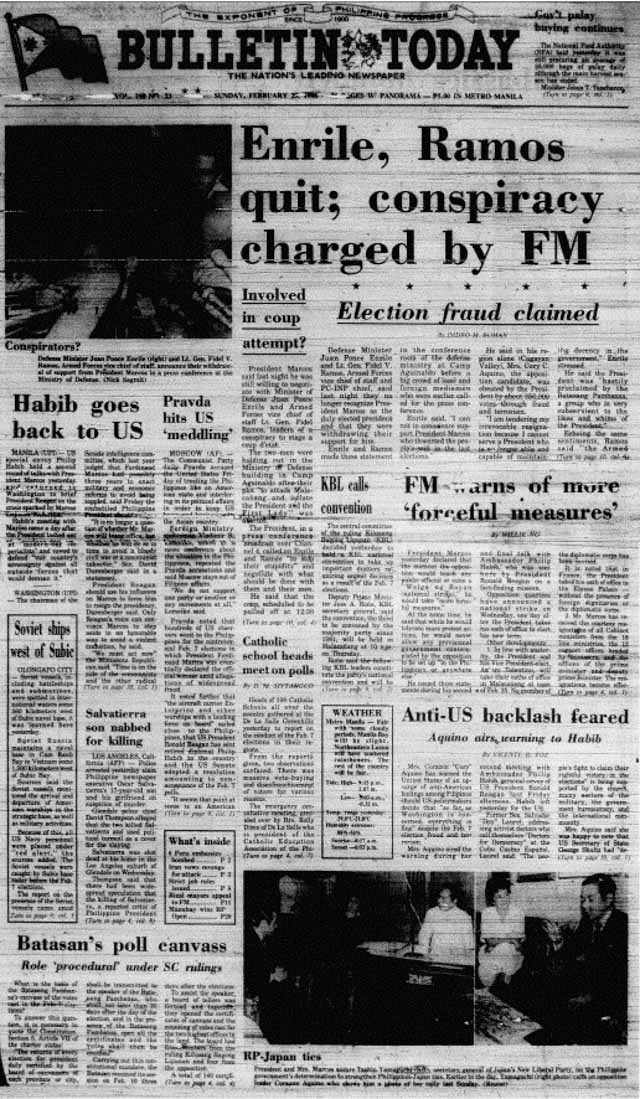
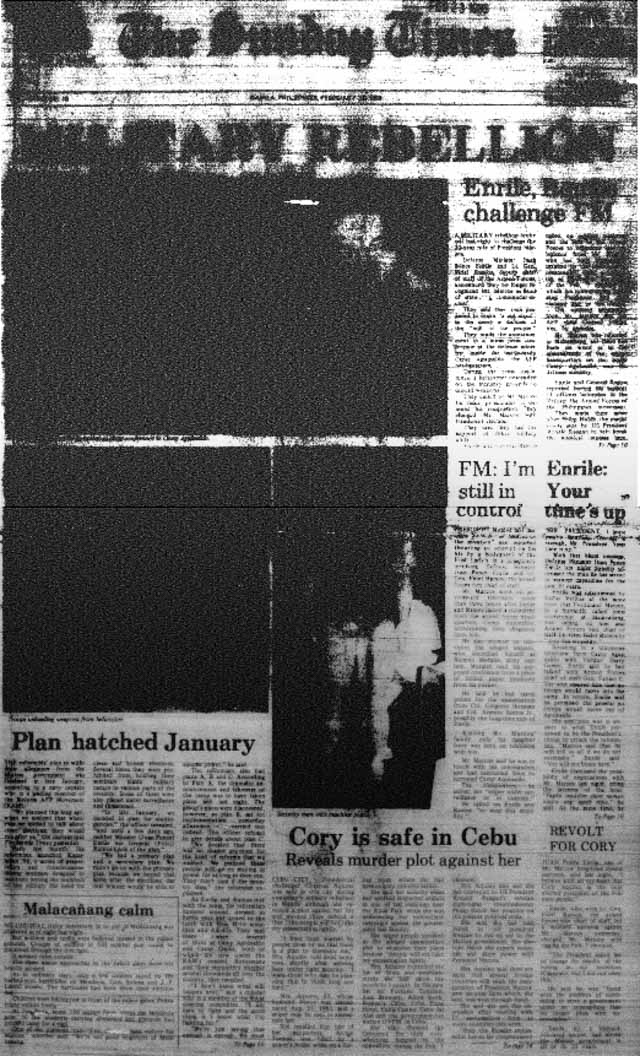
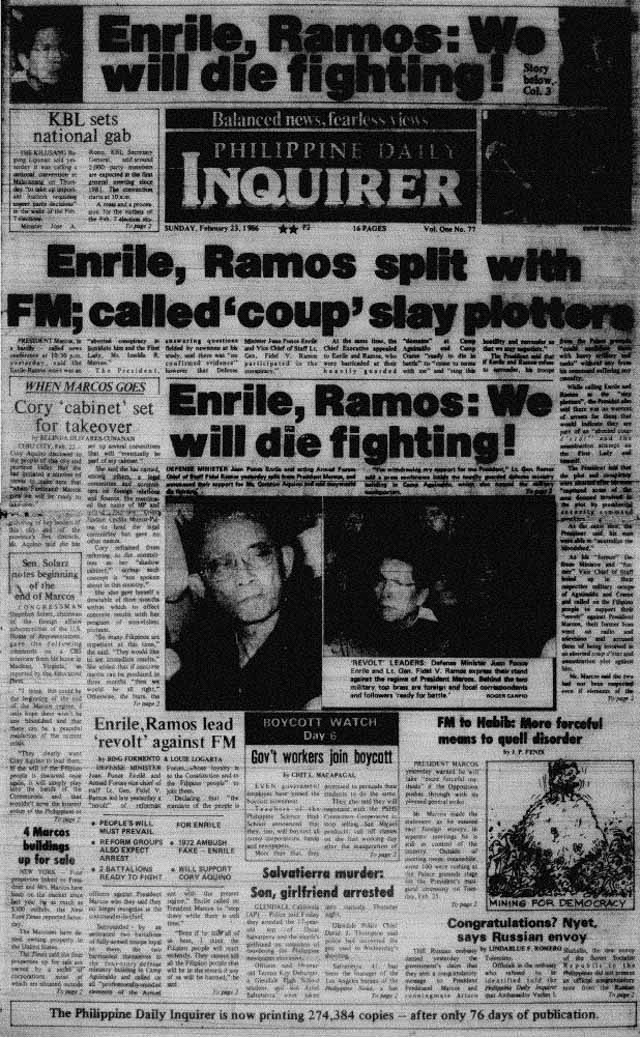
HIGHLIGHTS
- Thousands of Filipinos responded to Cardinal Sin’s appeal and started to flock and barricade rebel camps. They also brought food and other supplies to the soldiers.
- Ramos called the event “the revolution of the people” as he faced the public for the first time outside Camp Crame along EDSA.
- Then General Artemio Tadiar threatened to open fire at the crowd blocking his large marine contingent headed to the rebel camps. The people responded by singing “Bayan Ko” and even offered cigarettes and breads to the soldiers.
- Marcos, rejecting Enrile’s plea to stop tanks, offered him absolute pardon.
- Marcos received a letter from Pope John Paull II, delivered by then Papal Nuncio Bruno Torpigliani, requesting a “peaceful resolution” to the ongoing crisis.
FEBRUARY 24, 1986
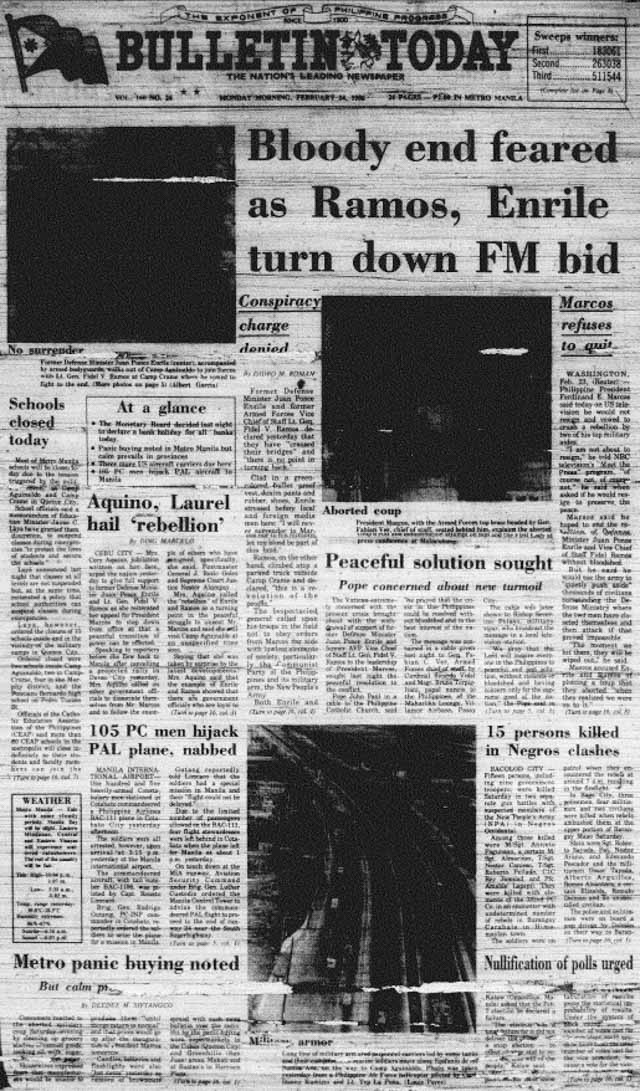

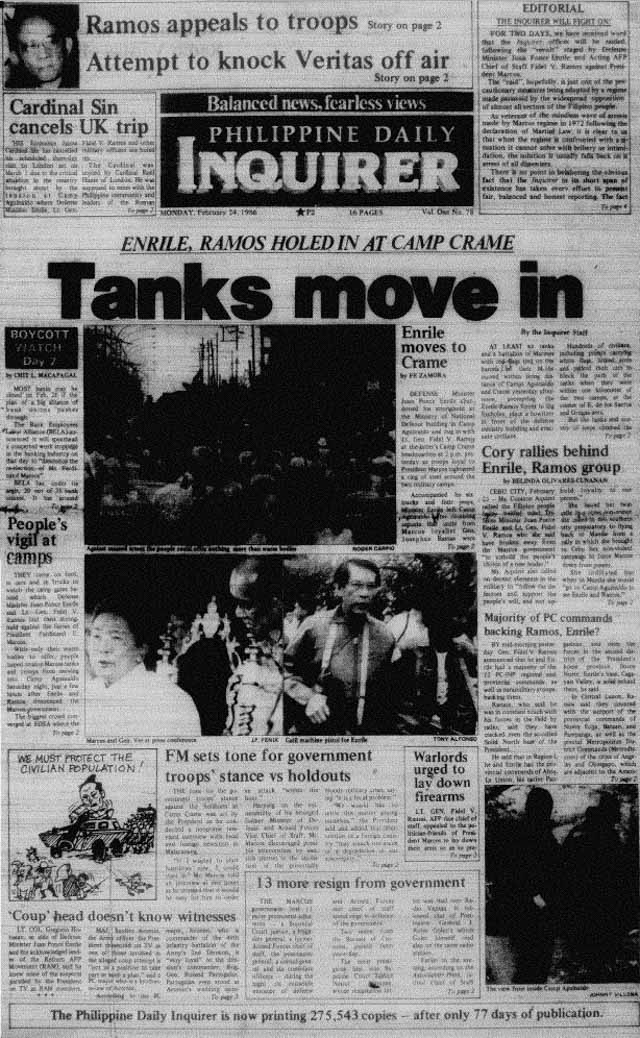
HIGHLIGHTS
- More people converge at EDSA as nuns and priests led human barricades to block armored personnel carriers from entering Camp Crame.
- Reagan issued a plea to Marcos to resign as the US endorsed Aquino’s government.
- Marcos appealed to loyalists to go to Mendiola to support him and his family.
FEBRUARY 25, 1986
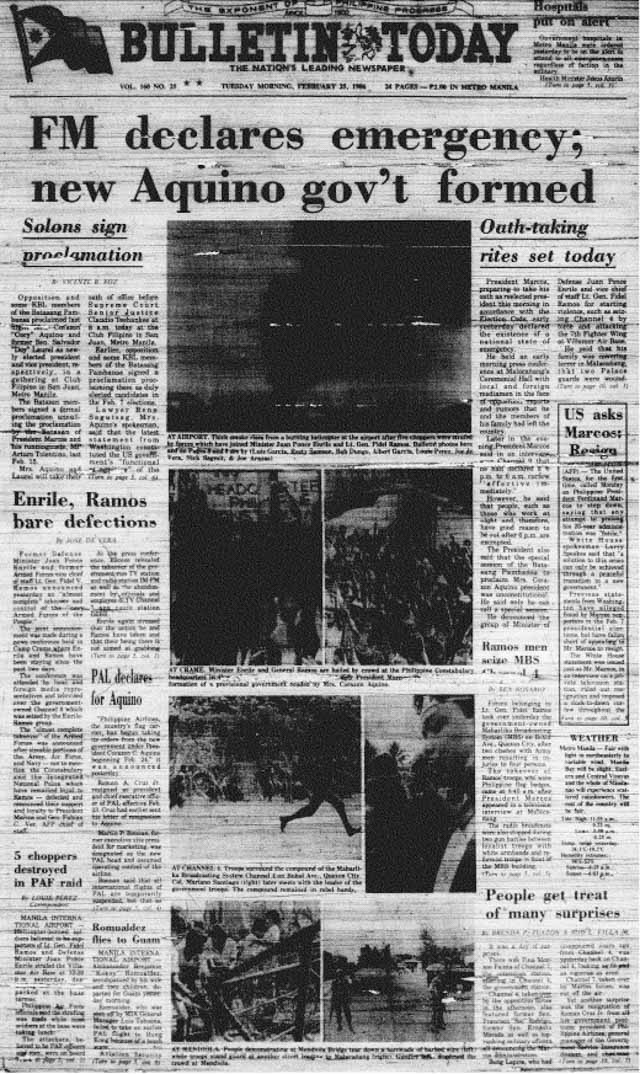
Only 6 people separate the Japanese adult star and the dictator
Rappler.com / Published 10:51 PM, January 28, 2013 / Updated 11:11 PM, January 28, 2013
Jodesz Gavilan@jodeszgavila? Published 8:00 AM, February 24, 2016 / Updated 5:46 PM, February 21, 2018
HIGHLIGHTS
- Tension rose as two sides bared plans for presidential inaugurations.
- Aquino took her oath as president before then senior associate justice Claudio Teehankee Sr at Club Filipino in Greenhills, San Juan. Former Senator Salvador Laurer was proclaimed vice president.
- Marcos had his own inauguration in Malacañang with then chief justice Ramon Aquino. He later appeared before 2,500 people with his entire family.
- The Marcoses and other government officials left Malacañang and were airlifted to Clark Air Base before taking off for Hawaii with the help of US authorities.
- Upon hearing about Marcos’ departure, crowds ransacked and looted the Palace.
FEBRUARY 26, 1986
HIGHLIGHTS
- The Marcos family and close allies arrived at Hickam Air Force Base. Their arrival marked the start of their exile in Hawaii until Ferdinand’s death in 1989 and Imelda’s return to the Philippines in 1991 to face charges of graft and tax evasion.
– Rappler.com
Sources: University of the Philippines’ University Library and Bayan Ko! Images of the Philippine Revolt
Support Free and Fearless Journalism
When Power insists, “you’re either with us or against us,” the space for a diversity of voices and ideas shrinks.
When hate and anger are weaponized, it creates a spiral of silence.
When critical questions are simplistically equated with an anti-government agenda, it requires courage to hold decision-makers accountable.
We launched Rappler in 2012 to marry the highest standards of journalism with technology to strengthen Philippine democracy.
We didn’t want to just give you the news; we aimed to promote critical thinking, self-reflection, and empathy to encourage informed decision-making.
Help keep us free and independent of political and commercial interests.
PHILIPPINES
Yolanda Ong vs Juan Ponce Enrile
Ong likes to believe her own battle with the Senate President and the unfolding Senate drama are connected in the quote ‘grand design’ to unmask Enrile
MANILA, Philippines – Aside from his war with four senator-critics, Senate President Juan Ponce Enrile also has his war with ad veteran Yolanda Ong.
Carmela Fonbuena filed this report.
YOLANDA ONG
ADVERTISING VETERAN
I really felt, ‘The nerve. The nerve! You’re the one who owes us an explanation.’
Advertising veteran and newspaper columnist Yolanda Ong is at war with Senate President Juan Ponce Enrile.
She is facing a 31.5-million-peso damage suit for writing a column that Enrile says is libelous.
Her column points out inconsistencies in claims Enrile made in memoir about his role in the Marcos regime.
She also links Enrile and his son Jack, a senatorial candidate, to alleged smuggling syndicate in Cagayan.
YOLANDA ONG
ADVERTISING VETERAN
First, I was unnerved. And then I got angry. Now, I am able to look at it from both a Zen perspective and at a same time a wide view. I think things are happening for a reason.
Ong makes a bold move. She files a counterclaim demanding Enrile to pay her 88 million pesos.
YOLANDA ONG
ADVERTISING VETERAN
It’s actually two counterclaims, in effect. The first one is for unfounded libel case. And the second one is for harassment and for impinging on my freedoms. The sum of which happened to be 88 million pesos. But I guess you could put many symbolisms behind the number. One for every year of existence.
Ong feels Enrile is singling her out. She believes it may have something to do with a political ad she produced for the 2001 senatorial elections, the first and only elections that the 88-year-old Enrile lost.
It was a part of a series of negative ads aimed at discrediting candidates who supported of ousted President Joseph Estrada. It shows Enrile calling on Filipinos protest against President Gloria Arroyo a few days before the so-called Edsa Tres.
JUAN PONCE ENRILE IN OLD ADVERTISEMENT
Ilipat natin ang ating demonstrasyon doon sa malapit sa kanila para marinig nila ang tunay na tinig ng bayan.
The ad reminded voters of Enrile’s alleged role in the violent and unpopular protest that was meant to reinstall Estrada.
Turned down by many lawyers, Ong finally gets human rights lawyer Chel Diokno to defend her against Enrile.
It’s no longer just about the damage suit. Ong likes to believe her own battle with the Senate President and the unfolding Senate drama are part of the so-called “grand design” to unmask Enrile.
RAPPLER IQ
Key players in the 1986 People Power Revolution
Who were the prominent figures of EDSA 1986 and where are they now?
NEW PRESIDENT. President Corazon Aquino takes her oath as president, marking the culmination of the 4-day People Power Revolution in 1986. Photo from Official Gazette
MANILA, Philippines – This year marks the 32nd anniversary of the 1986 People Power Revolution.
The 4-day event from February 22 to 25 will forever be etched in history as the “bloodless” revolution, which culminated with the end of a dictatorship that was also marked by human rights violations.
Thousands of Filipinos took to the streets and clamored for freedom from the two-decade iron fist rule of then president Ferdinand Marcos.
Rappler recalls the prominent figures of that period and the roles they played during the people’s revolt and revisits their post-EDSA lives.
Corazon Aquino
Corazon Aquino, a self-proclaimed housewife, became a prominent figure of the opposition after the death in 1983 of her husband, also the staunchest critic of Marcos, Benigno Aquino Jr.
Her loss in the presidential snap elections against Marcos in 1986 was widely believed to have been attended by fraud, sparking a “People Power Revolution”. The 4-day uprising ended with her taking her oath as the 11th president of the Philippines.
Aquino served as president from 1986 until 1991, her administration hounded by several coup attempts, the Mendiola massacre, and power blackouts.
In 2008, she was diagnosed with colorectal cancer and died in 2009 at age 76.
Following her death, people clamored for her only son Benigno Aquino III to run for president under the Liberal Party (LP) in 2010. LP’s original presidential candidate, then senator Manuel “Mar” Roxas II, gave way to Aquino and eventually became his vice presidential running mate.
LAST HURRAH. Ferdinand Marcos’ ‘final’ speech at Malacañang Palace after his inauguration and before his flight to Hawaii. Photo from the Presidential Museum and Library
Ferdinand Marcos
Ferdinand Marcos held on the presidency from 1965 until the uprising forced him and his family to leave the country in 1986. His two-decade rule saw the imposition of Martial Law and various human rights abuses – especially against those he deemed critical of the government.
As disdain for his administration grew, Marcos called for a snap election in 1985 with Arturo Tolentino as his running mate. In 1986, he won but faced allegations of tampered results to favor him over then opposition bet Corazon Aquino.
He, however, maintained that he had won a 4th term amid the growing supporters of the opposition and defecting government officials as reflected during the People Power Revolution. In February 25, Marcos took oath as president in Malacanang Palace but, together with his family and close allies, fled to Hawaii with the help of United States authorities later that day.
Marcos died after two years in exile on September 28, 1989. His body was flown to the Philippines – and later interred inside a crypt in his bailiwick Ilocos Norte – in 1993.
In 2016, after the victory of President Rodrigo Duterte, the long-running issue of whether or not former president Ferdinand Marcos should be buried at the Libingan ng mga Bayani (Heroes’ Cemetery) has finally been put to rest. Marcos was stealthily buried at the Heroes’ Cemetery past noon on November 28, 2016 with full military honors. (TIMELINE: The Marcos burial controversy)
FINAL OATH. The Marcos family moments after taking his oath of office in ceremonies at Malacañang Palace on Feb. 25, 1986. Photo from the Presidential Museum and Library
Imelda Marcos and the Marcos children, Bongbong, Imee, and Irene
Imelda Marcos spent most of her time as First Lady projecting the Philippines to the world through extravagant events and infrastructure such as the Cultural Center of the Philippines and the controversial Manila Film Center.
But the so-called Steel Butterfly is also famous for her vast shoe collection which was reported to contain more than 1,000 pairs.
After 6 years in exile and two years since her husband’s death, she was allowed to go back to the Philippines in 1991. Her political aspirations pushed her to run for president during the 1992 presidential elections but she lost. Three years after, she was elected first district representative of Leyte.
REELECTIONISTS. Vice presidential candidate Bongbong Marcos joins Ilocos Norte 2nd District Representative Imelda Marcos and Ilocos Norte Governor Imee Marcos who file their certificates of candidacy. Photo from the Provincial Government of Ilocos Norte
Now 86 years old, Imelda is on his third term as 2nd district Representative of Ilocos Norte.
Among the 4 Marcos children who spent a huge part of their childhood living a privileged life as presidential children, two are also serving as government officials along with their mother.
Ferdinand “Bongbong” Marcos Jr served as Ilocos Norte governor and representative before being elected to the Senate in 2013.
The only Marcos son – who closely worked with his father during his reelection bid and eventually during the People Power Revolution in 1986 ran for the vice presidency as running mate of Senator Miriam Defensor Santiago in the 2016 polls. He lost to Liberal Party’s Leni Robredo but is now contesting the election results.
Imee Marcos, who had held government positions during her father’s regime – Kabataang Barangay head and Ilocos Norte Assemblywoman from 1984 to 1986 – returned to politics as 2nd district representative of their bailiwick in 1998. She is currently the governor of Ilocos Norte. (READ: 3 generations of Marcoses run for local posts in Ilocos Norte)
SUPPORT. Fidel V. Ramos and Juan Ponce Enrile call for support. Photo from the Presidential Museum and Library
Defense Minister Juan Ponce Enrile
Juan Ponce Enrile is regarded as the architect and implementer of martial law as defense minister under Marcos. But after the 1986 snap election, he, together with then Lt General Fidel Ramos, publicly declared withdrawal of support for Marcos.
Enrile later served as National Defense secretary but eventually resigned in the latter part of 1986. He later became a senator in 1987 and in 1995.
In 2014, Enrile was indicted for plunder and graft before the Sandiganbayan in relation to the misuse of the Priorirty Development Assistance (PDAF) Fund. He was detained, and after more than a year, regained temporary liberty after posting bail amounting to P1.45 million ($30,462.50)* in 2015. (TIMELINE: Enrile and the pork barrel scam)
YEARS LATER. This is how former president Fidel Ramos and Senator Juan Ponce Enrile look like in 2016.
Fidel V. Ramos
Fidel V. Ramos was the AFP Vice Chief and also the Philippine Constabulary chief under the Marcos administration.
In February 1986, he resigned and withdrew support from the government to support the rebel soldiers. He and Enrile were called out over radio by Marcos, who asked them to “stop this stupidity.”
Ramos was appointed AFP chief of staff and later National Defense secretary under the Aquino administration, defending it against several coup attempts.
In 1992, he ran for president with the support of Aquino and eventually won against Miriam Defensor Santiago, Ramon Mitra Jr, and former First Lady Imelda Marcos, among others. He got 24% of the votes. It was during his presidency when the Philippines 2000 socio-economic program was implemented.
Ramos was also instrumental in the second EDSA Revolution against then president Joseph Estrada in 2001.
INSTRUCTIONS. Then Gen. Fabian Ver (R) consults then president Ferdinand Marcos in Malacañang. Photo from the Presidential Museum and Library
Fabian Ver
Fabian Ver was AFP chief under Marcos and was accused of masterminding the assassination of Benigno Aquino Jr. He, together with other soldiers implicated by the fact-finding commission, was acquitted in 1985.
A known strong ally of the dictator who often clashed with Enrile and Ramos, Ver stood with Marcos throughout the non-violent revolution from February 22 to 25. Several accounts said that he, together with Bongbong Marcos, continually urged the president to blow up rebel camps.
Loyal until the end, Ver and his family fled with the Marcoses and other cronies to Hawaii as Marcos’ 21-year rule came to an end. He did not return to the Philippines as Ramos and Aquino considered him a threat to national security.
Ver died in 1998 in Bangkok and was buried in his hometown of Sarrat, Ilocos Norte.
RENEGADES. Members of the Reform the Armed Forces Movement (RAM). Photo from the Presidential Museum and Library
Reform the Armed Forces Movement
The Reform the Armed Forces Movement (RAM) was formed in 1982 by junior military officers who were against corruption and cronyism in the AFP. The movement was also considered an important player in the revolt against the Marcos dictatorship.
RAM helped Enrile plan a mutiny but was later foiled. It was then when Enrile enlisted the help of Ramos.
Among the members of RAM were Enrile’s aide-de-camp at the time, Gregorio “Gringo” Honasan II, and Lt Col Eduardo “Red” Kapunan.
NOW. Red Kapunan (L) during his trial in 2013 and Gregorio Honasan (R) as he files his certificate of candidacy for vice president in 2015.
The bemoustached Honasan would later lead at least two unsuccessful coup attempts against the very person he and his group supported for the presidency. He was also accused of masterminding the 2003 Oakwood mutiny against the administration of then president Gloria Macapacal Arroyo.
Honasan has been a senator for 4 terms already, first running as independent in 1995. He now faces a graft complaint over the PDAF scam and is now gunning for the vice presidency under the United Nationalist Alliance of Vice President Jejomar Binay.
Kapunan, meanwhile, was implicated in the murder of labor leader Rolando Olalia and Leonor Alay-ay in November 1986. He was detained in 2012 but was released on bail in 2014.
INFLUENTIAL LEADER. Comelec chairman Victorio Savellano kisses the ring of Jaime Cardinal Sin during a Mass at the Manila Cathedral. Photo from the Presidential Museum and Library
Jaime Cardinal Sin
The late Jaime Cardinal Sin was instrumental in rallying thousands of Filipinos to flock to EDSA during the people’s revolt against the Marcos dictatorship.
On February 22, the Manila Archbishop rallied people to support Ramos, Enrile, and other rebel soldiers. He aired his plea for food and other aid over Radio Veritas – the Catholic Church-owned radio station which broadcast developments in the uprising against Marcos in February 1986.
His plea came after his conversation with Enrile regarding his plans and the Catholic Bishops’ Conference of the Philippines’ condemnation of the fraudulent snap election.
He once again played a big role during another people’s revolt in 2001 against Estrada.
In 2005, Sin died due to renal failure at the age of 76.
TANDEM. Salvador P. Laurel poses in front of the Marcos bust in Baguio with his presidential contender in the 1986 snap elections, Corazon C. Aquino. Photo from Official Gazette
Salvador P. Laurel
Salvador P. Laurel was a leader of the United Nationalist Democratic Organization (Unido), the primary opposition party during the Marcos administration.
Despite him being named as the party’s presidential candidate, Laurel stepped aside and gave way to Aquino. He joined her campaign as vice presidential candidate. They both lost, however, in a fraud-marred snap election which eventually led to the People Power Revolution.
On February 25, Laurel took his oath as vice president at Club Filipino. In 1992, he failed to win the presidency after Aquino threw her support behind Ramos.
He later served as chairman of the Philippine National Centennial Commission from 1996 to 1999. He was charged with graft in relation to the Centennial Expo in the Clark Freeport Zone in Pampanga. He denied the charges.
Laurel spent most of his private life after retiring from politics in the United States where he died from lymphoma in 2004.
MARCOS LOYALIST. Arturo Tolentino votes during the snap elections. Photo from the Presidential Museum and Library
Arturo Tolentino
Arturo Tolentino was Marcos’ vice presidential running mate during the 1986 snap elections against Aquino and Laurel. He won but the results were suspect.
Tolentino later launched a coup stating that he was “constitutionally the acting president”, and together with Marcos allies, barricaded the Manila Hotel on July 8, 1986. He, however, did not get the huge support he was expecting and eventually dispersed the crowd two days after.
He won a Senate seat in 1992 and retired from politics in 1995. Tolentino died of a heart attack in 2004. – Rappler.com
Special’ treatment for Juan Ponce Enrile
In granting bail to a senator accused of plunder, 8 Supreme Court justices rule in favor of the powerful
Rappler.com
Published 9:00 AM, August 24, 2015
Updated 11:27 AM, August 26, 2015
Senator Juan Ponce Enrile, accused of pocketing P172 million from public funds, is out on bail, after a year in detention.
The Supreme Court set him free on 2 grounds: he is not a flight risk and his health is “fragile.” (Read the decision here)
In justifying the decision to grant bail to a senator charged with plunder, Justice Lucas Bersamin extolled Enrile’s virtues: “With his solid reputation in both his public and his private lives, his long years of public service, and history’s judgment of him being at stake, he should be granted bail.”
Why such accolades? Because, in Bersamin’s view – which 8 other justices shared – “his social and political standing and his having immediately surrendered to the authorities…indicate that the risk of flight…is highly unlikely. His personal disposition from the onset of his indictment for plunder…has demonstrated his utter respect for the legal processes of this country.”
The Court also stressed Enrile’s poor health as a “compelling justification” for his freedom, quoting extensively from a Philippine General Hospital doctor who conducted medical examinations.
The Court’s decision is unprecedented.
Philippine courts have always followed a long-standing procedure in criminal cases that the grant of bail is determined on the strength of the evidence, which takes place during bail hearings, not before. In Enrile’s case, the trial hasn’t even begun, the evidence hasn’t been assessed, yet he’s already free.
This opens the floodgates to all those accused of plunder. A beeline to the Sandiganbayan is likely.
Justice Marvic Leonen, in his eloquent 29-page dissent, said it clearly: “…it puts pressure on all trial courts and the Sandiganbayan that will…be deluged with motions to fix bail on the basis of humanitarian considerations… The lower courts…will have to decide whether this is applicable only to Senators and former Presidents charged with plunder…”
(Read Leonen’s dissent)
In essence, Leonen pointed out, the Court gave Enrile “special accommodation,” and it “may benefit one powerful public official at the cost of weakening our legal institutions.”
This case reminds us of the Court’s ruling to allow then President Gloria Arroyo to appoint a midnight chief justice in 2010, just before the May elections. Most of the characters are the same.
Bersamin is the justice who penned the controversial decision. He performed legal cartwheels, exempting the judiciary from the appointments ban during the election campaign period.
The lawyer who argued this point in his petition in favor of a midnight appointment was Estelito Mendoza, the same lawyer in the Enrile bail case. Mendoza is widely regarded as the “lawyer of last resort.”
The 8 justices who voted in favor of Enrile – Bersamin, Presbitero Velasco Jr, Arturo Brion, Mariano del Castillo, Disodado Peralta, Jose Mendoza, Jose Perez, Teresita Leonardo-De Castro – are all appointees of Arroyo. Most of these 8 justices also voted in favor of the midnight appointment by Arroyo.
It is not far-fetched to say that the detained ex-president could benefit from this decision.
All this comes at a time when the country is gearing up for the presidential elections next year. President Aquino’s successor will have the privilege of appointing 11 Supreme Court justices.
The Enrile case is a jolting reminder of the importance of electing a president who will appoint independent-minded justices and with impeccable integrity. – Rappler.com
THOUGHT LEADERS
Dear Juan Ponce Enrile
I hope that after your conviction, all those you intimidated and harmed before, during, and after martial law will find the courage to tell their stories. I hope that you live to hear those stories.
Sylvia Estrada Claudio
Published 10:30 AM, July 21, 2014
Updated 9:34 AM, August 18, 2014
Last year, the 41st the anniversary of the declaration of martial law, I wrote a long post about you ending with, “Old as you are, you may never be brought to justice. And I doubt your conscience bothers you, enamored as you seem by unearned wealth and the pomp of your dishonorably gained positions. But I remember and will remember, with the hope that history will, like me, condemn.”
How much has changed in less than a year.
And now, as you, a 90-year-old, are confined to a hospital under arrest, let me charge you with what has been in my heart all these years. Because I do accuse you. And not just with the plunder charges the government has filed against you.
I accuse
I accuse you of torture and murder. Not just of people unknown to me, but also of my friends. I accuse you of having committed the crime of plunder long before you stole your PDAF as a senator.
I do this not out of vindictiveness, but out of a need for healing that you owe me and all those who passed through martial law. I do not do this in anger, but in order to share with those who did not go through those years. They need to understand why you and those like you should never ever be allowed to have power again.
Now is a good time. If we did not learn our lesson then, it is time to look back now – time to realize that those who betray the nation are likely to betray it again. As you have done after martial law.
Ah, what catharsis to write this! What a relief to be able to call you names. I remember how you would punish people who criticized you, Marcos, and your cabal. This is what you did to my friend and former Philippine Collegian editor, Abraham Sarmiento, Jr. You imprisoned him for writing editorials critical of martial law. You released him only after you personally expressed displeasure over the editorials. I know because he told me. He stuck to his principles after release. You imprisoned him again and kept him in a cell until his health had so deteriorated he died shortly after his second release. Even as you seemed to recover your career, I often comforted myself with the thought that at least the sacrifices of those who fought the dictatorship allowed me the freedom to criticize you. That I did not do so daily was merely because of my limitations and not out of new-found respect for you.
Do you think I have forgotten my mother’s years of excruciating worry as she watched me go deeper and deeper into the anti-dictatorship struggle? Oh, how her friends would comfort my mother, “Don’t worry, Rita. If she gets caught I will agree to his advances and spend the night with him in exchange for your daughter’s freedom.” Yes, even then we knew that you were a predator as well. You were so lascivious my humble family knew of two people whom you had propositioned. You abused power to the maximum. You made us see with clarity what Hannah Arendt calls “the banality of evil.”
Detention, torture during martial law
And I, like many who lived through those years, knew of your evil as a daily reality. My first job as a young doctor was with a health and human rights organization. I worked with those who had been tortured. Those days, detention and torture were almost a sure-fire combination. So I and a couple of colleagues would make the rounds of the detention centers with every new report of an arrest, hoping that, with a quick response, people would be tortured less, not killed.
We would present ourselves at the detention centers to any officer who would see us. (They never had a real system for us. That would mean some form of accountability.) We had to be brave because we knew at once this marked us as communist enemies. But they also had to have a semblance of regularity. So our requests would be considered. If the officer was a tough psychopath, he would just say “no” outright. But this would give us ammunition to go squealing to international human rights groups.
So we would often have to wait for hours for someone from the Judge Advocate General’s Office (JAGO) to make a decision. I never met anyone from JAGO then. I did often get turned away by that office. If the JAGO turned us away, we would write you. Very rarely, for reasons unknown, you or JAGO would agree to our visit, often after weeks of delay. We always thought the delay was to ensure the torture would continue. Marcos, you and your military believed in torture as an investigation technique. After the torture, you would have us wait a few more days until the physical evidence of torture had disappeared. If there was enough international pressure; if you wanted us off your backs; if our seeing the detainees would not cause you any harm, you let us see them.
But they would tell us their stories. A detainee was lucky if all he or she got was getting beaten within an inch of their life. (I guess they left that for the amateurs called fraternity boys.) Electrocution, water boarding, rape and other forms of sexual harassment, sleep deprivation, hearing your wife being raped, hearing your comrades being tortured, being asked to sit on a block of ice while naked – your minions were so depraved in what they created.
Six weeks ago, labor leader Romy Castillo died of lung cancer. In 1984 your military electrocuted his testicles, put a barbecue stick up his penis, repeatedly submerged his face in a feces-filled toilet bowl. They beat him and played Russian roulette on him. I cannot forget the day, shortly after his ordeal, when I visited him in detention. I will not let you forget his story nor escape your liability for it.
Your military killed my childhood friend Lorenzo Lansang when he was only 19 years old. He was summarily executed in a field in Quezon province. Your hands are smeared in his blood and I will always point out how bloody they are.
I blame you and Marcos for the corruption and brutality of the military and police today. I still keep abreast of the torture situation. And it looks like the police and military have no idea how to interrogate and investigate without varying degrees of torture and intimidation thrown in. They have become addicted to it. All those recent reports of human rights violations by state authorities? Your face is on the logo.
And I remember that your wealth came from the thievery of the martial law years. It does not therefore surprise me that you stole your pork barrel funds.
You find me too dramatic? I could fill entire pages with more stories. And I am not alone. How lucky that I am much younger than you. I and my cohort will live after you and tell our tales.
Karma
Dear Johnny boy, I bet you miss the days when you could have imprisoned me for this. When you could have had your military rape me as revenge. I, on the other hand, am so glad you are under arrest now. Defanged, at last. Hopefully forever.
Unlike you, however, I would not wish torture upon those I truly think are enemies of the people. In short, I would not torture you. I would not deny you seeing your lawyers or doctors or relatives as you did to so many during martial law. It is fitting though that you may suffer in detention more than usual. I do note that you may be experiencing pain because you are old and infirm. I note it.
Your conviction will be so good for our country. It will show that such diabolical behavior will not always be rewarded. That somehow power can end and then a price will have to be paid. It may deter future wrongdoing. It may convince a few more people not to value the things you value.
The only thing I am afraid of is that you are morally incompetent. So much of your record indicates “sociopath.” I fear that it does not matter to you what people think or will remember. It isn’t right that your punishment will be so short because you’re not likely to live 20 more years. That was the amount of time you kept our people subjugated to martial law. So I can only hope that you at least care enough so that the last days of your life can be lived in regret.
I am hoping you care about how history will remember you. You did write and spend for the publication of that lie of a memoir. So I hope that you live to see your conviction. That after your conviction, all those you intimidated and harmed before, during, and after martial law will find the courage to tell their stories. I hope that you live to hear those stories.
But for now, this is my story. And before you go, I want you to know that the other stories will come. It’s called History. It’s called karma. – Rappler.com
Sylvia Estrada-Claudio is a doctor of medicine who also holds a PhD in Psychology. She is Professor of the Department of Women and Development Studies, College of Social Work and Community Development, University of the Philippines. She is also co-founder and Chair of the Board of Likhaan Center for Women’s Health.
.
For comments, Email to :
D’Equalizer | [email protected] | Contributor.


